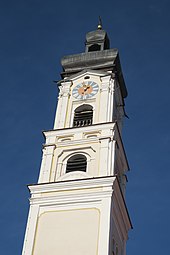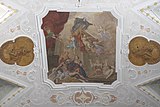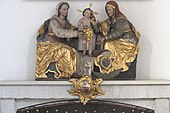St. Emmeram (Geisenfeld)
The Roman Catholic parish church of St. Emmeram and former Benedictine abbey church of the Assumption of Mary in Geisenfeld , a municipality in the Upper Bavarian district of Pfaffenhofen an der Ilm , is essentially a Romanesque building from the early 11th century. It was originally built as a monastery church for the Benedictine Abbey of Geisenfeld , a noble women's monastery. In the 18th century the church received a splendid interior in the style of the baroque and early rococo . Gothic frescos were exposed again in the 1970s . The church consecrated to St. Emmeram of Regensburg is one of the protected architectural monuments in Bavaria.
history
The current parish church was built in 1030 with the foundation of the Benedictine convent in Geisenfeld by Count von Ebersberg Eberhard II and his wife Adelheidis. The monastery and church were dedicated to the Assumption of Mary and St. Zeno . In 1384 a new Gothic style choir was built. Further alterations were made in 1602 when the net ribs in the choir were replaced by pearl rod profiles. After the renovation of the monastery buildings had already started in 1701, the abbess Maria Cäcilia Weiß had the church redesigned in the Baroque style from 1728. In the course of this construction work, the upper clad windows and the windows of the side aisles were enlarged, the south tower was raised and fitted with a clock and a curved hood with a lantern . On April 15, 1730, the church was consecrated by the Regensburg Bishop Johann Theodor von Bayern . After the secularization of the monastery in 1803, the church served as a parish church and took over its patronage . The old parish church of St. Emmeram, a few meters away, had become dilapidated and was demolished in 1873. During the restoration in 1876, the baroque furnishings of the church were partially removed and replaced by a neo-Gothic one. In 1906/08 the neo-baroque high altar with the painting of the Assumption of Mary by the Veronese painter Marcantonio Bassetti was installed in the choir. The baroque version from the 18th century was used as the basis for the renovation in 1971. As part of this work, the late Gothic frescoes on the choir vault were exposed again. During the exterior renovation in 1980, the exterior color scheme from 1730 was restored.
architecture
Exterior construction
The church is a Romanesque, three-aisled pillar basilica with a double tower facade in the west and a Gothic choir with a five-eighth end in the east. The oldest parts of the church include the lower north tower, covered with a pyramid roof, the so-called donor tower, in the ground floor of which dazzling fields framed by arched friezes are cut, and the lower floors of the south tower, whose two storeys, which were raised in the 18th century, were richly structured Have cornices and pilasters .
inner space
The interior is divided into high arched arcades resting on pillars , over which a slightly cranked cornice runs and which open the two-storey central nave to the two side aisles. The pillars are decorated with flat pilasters that continue on the high wall up to the vault. The pilasters follow the hierarchical order, they have Ionic capitals below and Corinthian capitals above . The central nave is covered by a flat needle cap barrel, the side aisles are groin-vaulted . The choir, which is raised by three steps and to which a slightly tapered archway leads, is illuminated by large, three-lane tracery windows and covered with a ribbed vault. On the north side of the choir are the sacristy , which was furnished with a richly decorated stucco ceiling and cupboards in the Baroque period, and the Romanesque cruciform chapel, the former charnel house of the monastery. The two-storey oratorios are located on the south side.
Ceiling paintings
Gothic frescoes
The late Gothic frescoes on the choir vault, which were exposed again during the renovation in 1971, were carried out in 1516. On them the church fathers , the evangelist symbols and angels with the instruments of suffering are depicted. Some of the figures are holding tapes in their hands. The apocalyptic lamb lying on the book with the seven seals is partially covered by a stucco rib built in 1602. Two more frescoes were exposed on the choir walls. On one scene, perhaps a representation of women who find the empty tomb after the resurrection of Jesus, a kneeling nun can be seen in the lower left corner, on the other scene two people can be seen under arcades. Another fresco in the south aisle depicts the beheading of a martyr, presumably St. Dionysius of Paris , who is venerated alongside St. Wolfgang and St. Emmeram as one of the main saints in the Regensburg monastery church St. Emmeram .
Baroque frescoes
The ceiling frescoes in the nave , like the stucco decoration made of banding and lattice motifs, were made by Melchior Buchner (also Puchner or Büchner), who also created the oil paintings of the twelve apostles on the walls of the nave .
At the transition to the choir, Maria Immaculata is shown on a smaller fresco . The adjacent yoke is vaulted by a false dome. The dome fresco is surrounded by the church fathers Ambrose of Milan (with a book and a beehive), Jerome (with a lion), Augustine (with a miter and a book) and Gregory the Great (with a book and a dove) and has a chronostitch showing the year 1728 results, the year from which the abbess Maria Cäcilia Weiß had the church redesigned in baroque style.
The founder of the monastery, Eberhard II, and his wife Adelheidis are crowned with laurel wreaths by the Pope on the donor fresco. The Mother of God hovers over the scene with the baby Jesus, next to the donors a builder holds the plan of the monastery in his hands. The coat of arms of the monastery and the abbess Maria Cäcilia Weiß, a swan and her initials MC, can be seen under the painting.
Another fresco shows the Lamb of God above, including the religious saints, Saint Benedict of Nursia and his sister Scholastica . The three female figures are allegorical representations of the order's vows of poverty, obedience, and chastity. The figures on the lower left of the picture symbolize the vices of curiosity, pride and lust, the Benedictine nuns kneel on the lower right.
A fresco commemorates the pilgrimage to the Geisenfeld miraculous image that hovers over the monastery church. In the middle are Mary, St. Anne and the baby Jesus, on the lower left side a house is on fire, below you can see prayers.
Another fresco is dedicated to St. Dionysius, a catacomb saint who, like St. Dionysius of Paris , is said to have suffered the martyrdom of being beheaded and whose bones the abbess Anna Theresia Pröbstl transferred from Rome to Geisenfeld in 1673 and placed in a grave in the south aisle chapel let accommodate. In the middle of the picture you can see a coffin with the corpse of the saint, which is carried by angels, underneath the sick people asking for help.
The smaller medallions of the side aisles - with the exception of the depiction of St. Anne - were painted over with oil paint , like the pictures on the gallery balustrade in the 19th century in the style of the Nazarenes .
Furnishing
- The altarpiece of the Assumption of Mary , painted in Rome in 1620 by the Veronese painter Marcantonio Bassetti, is integrated into the neo-baroque high altar from 1906/08 from the Munich art workshop Elsner ( father and son ) . The picture, which is dedicated to the patronage of the monastery church, was acquired in 1625 by Abbess Salome Dolnhofer for the Geisenfeld Benedictine nuns. It bears the signature: "BASSETTI VERONA FACIEBAT".
- A Gothic altar hall made of limestone serves as the popular altar .
- The putti- studded pulpit was made in the Rococo style in the mid-18th century. St. John Nepomuk kneels on the sound cover , the pulpit is decorated with a gilded relief of the Good Shepherd .
- The confessionals , like the cheeks of the church chair, date from 1728. They are decorated with inlays , the images of the apostle Peter and Maria Magdalena are framed by quatrefoil medallions on the essays .
- In the Anna Chapel, a chapel in the north aisle, which received its stucco decoration around 1602, the miraculous image of Anna herself , which was previously the destination of a pilgrimage , is kept in a shell-crowned shrine . The wood-carved and colored group of figures, St. Anne seated on a throne with Mary and the baby Jesus on her lap, is dated around 1400.
- On the north wall of the chapel there is a carved figure of St. Emmeram from the 14th century, which was taken over from the old parish church. The saint is shown with his attribute , a ladder on which he was martyred. It is considered to be the oldest sculpture in the church.
- In the south aisle chapel hangs above the grave of the catacomb saint Dionysius, a painting by the Bavarian court painter Andreas Wolff from 1671 depicting the apotheosis of the martyr. It is flanked by the rococo figures of the Apostle John and John the Baptist . The group of figures of Anna herself third above the grave is dated around 1600.
- Under the organ gallery are the baroque carved figures of St. Blaise , who holds a candle in his hand as his attribute, and the Regensburg diocesan patron, St. Wolfgang with an ax in his hand.
- The busts and half-figures in the nave, like the 14 pictures of the Way of the Cross in the side aisles, also date from the Baroque period.
Tombs
Numerous grave slabs are set into the walls of the church, which are mainly reminiscent of abbesses of the monastery and which date from the 14th to 18th centuries. On the Tumbadeckplatte of the first abbess Gerbirgis († 1061) from the 14th century, the relief of the deceased is carved in full.
literature
- Georg Dehio : Handbook of the German art monuments. Bayern IV: Munich and Upper Bavaria . 2nd edition, Deutscher Kunstverlag, Munich 2002, ISBN 3-422-03010-7 , pp. 352–353.
- Jolanda Drexler-Herold, Angelika Wegener-Hüssen: Landkreis Pfaffenhofen ad Ilm (= Bavarian State Office for Monument Preservation [Hrsg.]: Monuments in Bavaria . Volume I.19 ). Karl M. Lipp Verlag, Munich 1992, ISBN 3-87490-570-5 , p. 12-16 .
- Anton Klinger: Geisenfeld / Obb . (= Small Art Guide No. 1240), Verlag Schnell and Steiner, Munich / Zurich 1980, ISBN 978-3-7954-4960-5 .
Web links
- City Parish Church of the Assumption of the Virgin, City of Geisenfeld
Individual evidence
- ↑ List of monuments for Geisenfeld (PDF) at the Bavarian State Office for Monument Preservation, monument number D-1-86-122-8
- ↑ Markus Wesche: A most venerable robbery. Saint Dionysius Areopagita in Regensburg . Bavarian Academy of Sciences (Ed.), Akademie Aktuell, Volume 2015, Issue 4, Issue No. 55, ISSN 1436-753X.
Coordinates: 48 ° 41 ′ 0.6 ″ N , 11 ° 36 ′ 49.3 ″ E

























